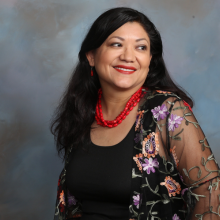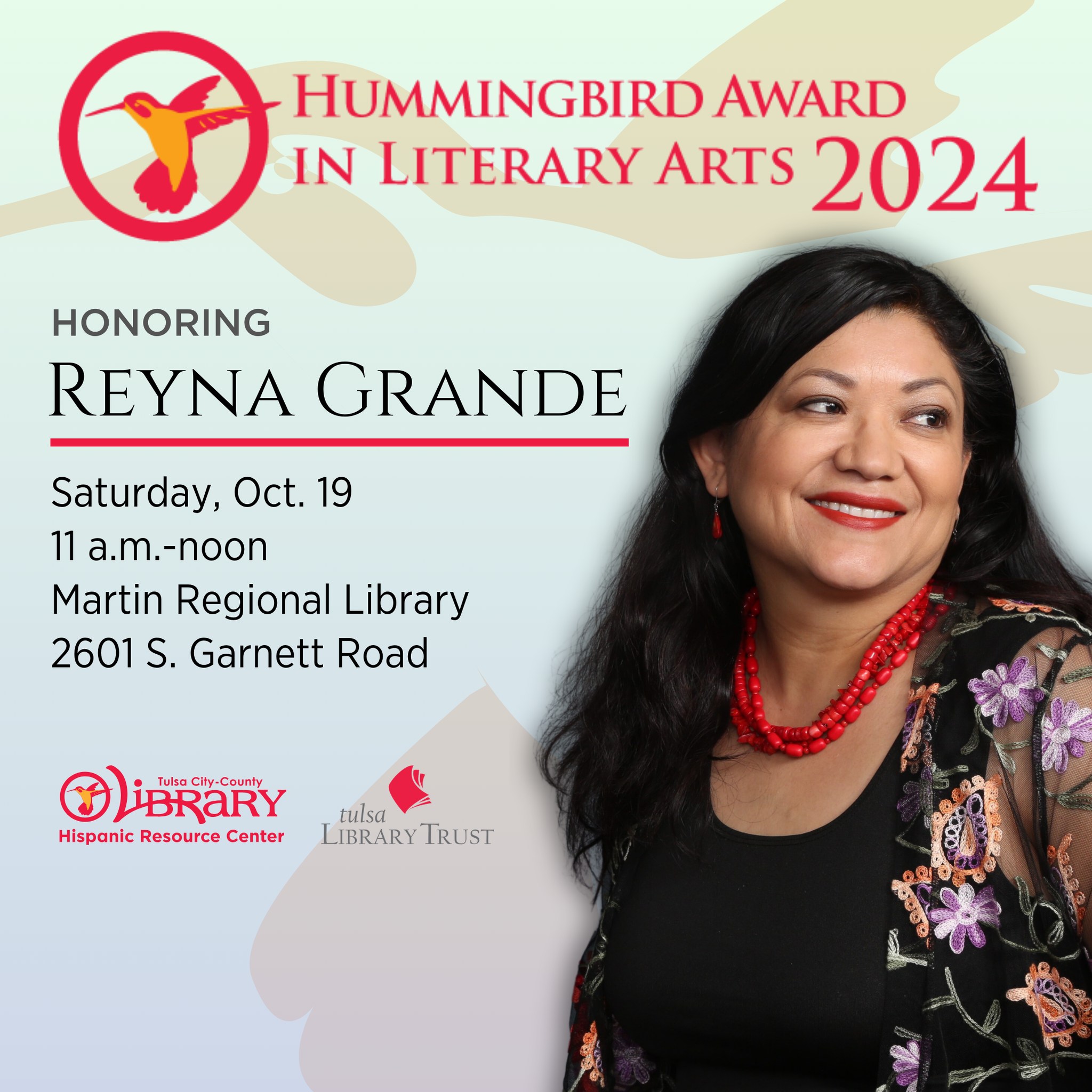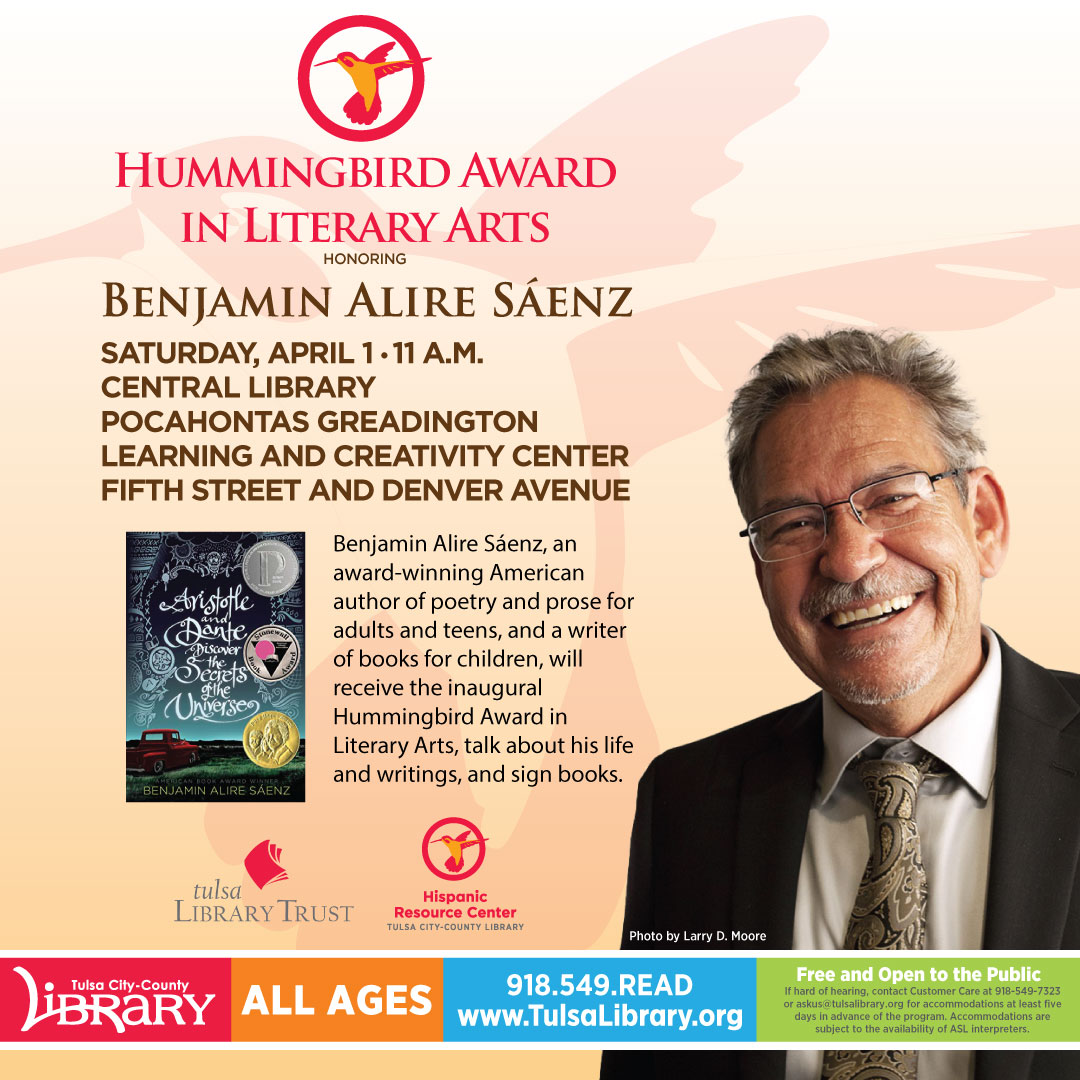What is the Hummingbird Award in Literacy Arts?
The Hummingbird Award in Literary Arts, or also known as the “Premio Colibrí en Arte Literaria” is a biennial award (occuring in even years) honoring and recognizing a nationally prominent author, poet, or artist whose work has elevated and affirmed the voice of the Latinx community.
The award is given to a distinguished individual of Latinx-descent who has shifted the narrative for the Latinx community and paved the way for future generations through their outstanding work. In addition, this author will have successfully encapsulated the diverse culture, perspective, and voice of the people. The award consists of an engraved plaque and a prize of $10,000. The recipient will give a public address on the day of the award presentation.
The Hispanic Resource Center (HRC) Author Selection Committee is appointed by the HRC Coordinator, by which the committee will work together to determine the candidates for the award. Thus, the committee will not accept applications from authors or publishers.
¿Qué es el Premio Colibrí en Arte Literaria?
El Premio Colibrí en Arte Literario, también conocido como "Hummingbird Award in Literacy Arts", es un galardón bienal (que se otorga los años pares) que honra y reconoce a un autor, poeta o artista de destacado prestigio nacional cuya obra haya elevado y afirmado la voz de la comunidad latina.
El premio se otorga a una persona distinguida de ascendencia latina que haya cambiado la narrativa de la comunidad latina y haya allanado el camino para las generaciones futuras a través de su trabajo sobresaliente. Además, este autor habrá logrado plasmar con éxito la diversidad cultural, la perspectiva y la voz del pueblo. El premio consiste en una placa grabada y un premio de 10 000 dólares. El galardonado pronunciará un discurso público el día de la entrega del premio.
El Comité de Selección de Autores del Centro Hispano es designado por el coordinador del Centro Hispano, y trabajará en conjunto para determinar los candidatos al premio. Por lo tanto, el comité no aceptará solicitudes de autores o editoriales.
2024 HALA Recipient
The Hispanic Resource Center is thrilled to announce that Reyna Grande, the acclaimed American Book Award-winning novelist and memoirist, has been chosen to receive the 2024 Hummingbird Award in Literary Arts.

About Reyna Grande:
Reyna Grande is the author of the bestselling memoirs The Distance Between Us and A Dream Called Home, where she shares her experiences before and after arriving in the United States from Mexico as an undocumented child immigrant. Her other notable works include the novels Across a Hundred Mountains, Dancing With Butterflies, and A Ballad of Love and Glory, which is set during the Mexican American War. Additionally, she co-edited the anthology Somewhere We Are Human: Authentic Voices on Migration, Survival and New Beginnings, featuring stories by and about undocumented Americans.
Born in Iguala, Guerrero, Mexico, Reyna Grande was just 2 years old when her father left for the U.S. to find work, followed by her mother two years later. In 1985, at the age of 9, Reyna made her own journey north. She attended Pasadena City College before transferring to the University of California, Santa Cruz, where she became the first in her family to graduate from university.
2024 Presentation
Saturday, Oct. 19
11 a.m. - Noon
Martin Regional Library
2601 S. Garnett Road

Award Criteria & Selection Process
Terms
- One plaque and monetary award will be presented every two years at a Tulsa City-County Library awards ceremony. The award will be presented to a Latinx author, poet, or artist whose outstanding work has adequately captured the experience and voice of the Latinx community.
- The selected author or artist may specialize in any age category, genre, and their work may be available in Spanish, English, or bilingual formats (work in a language native to a region and/or spoken by indigenous communities also qualifies).
- The author or artist must be of Latinx heritage or descent to be a recipient of the award.
- If suitable candidates are not found, the awards will not be presented in that year.
The Process: Selecting a Candidate
- The process of selecting a candidate will take 2-3 months with an estimate of 3 meetings total, of which only 1 is required to be in-person. This will give enough time for the committee to research or read the work of the candidates as they are being proposed and evaluated during the meetings.
- The first task of the selection committee will be to generate a longlist of candidates. This longlist will be created by asking each committee member to submit 2-3 names to the list by-email within a week of the process beginning.
- Staff advisory members will create author profiles for all nominees and give the committee 2 weeks to review them.
- The committee will then convene in-person to narrow down the longlist to a shortlist.
- The final process is giving the committee one month after the in-person meeting to research/read about the shortlist nominees and rank them from 1-5. Scorecards/Rankings will be due to the HRC Coordinator within a month.
- After the staff advisory members combine the totals of the rankings and come up with the ranked list of 3 finalists, we'll start reaching out to them in ranked order until one accepts.
Author Selection Committee Commitment & Roles
The HRC Author Selection Committee composed of members of the community will vote from a narrowed list of award candidates to decide on 2 ranked finalists, and an alternate finalist. The HRC Author Selection Committee will serve a term of 2 cycles, and since the award is biennial, the members are invited to serve on the committee for 4 years. This is not a strict time commitment, as we understand special circumstances may change availability. The committee will be made up of at least three leaders or community partners of the Latinx/Hispanic community in Tulsa and non-voting TCCL staff that will have the ability advise on the list of candidates for voting members.
Voting
Voting will be conducted through a point system; the voting members will be asked to assess and pick from a list of 5 candidates for the award. They will pick their 1st choice, 2nd choice and 3rd Choice. At the end, first choice picks will be worth 3 points, 2nd will be worth 2 points, and 3rd choice will be worth 1. Points will be totaled and we will ideally have 2 finalists, and an alternate finalist.
Symbolism
- For the Taino, the hummingbird is a symbol of rebirth, and even though they are small, they have the fierce heart of an eagle. The Taino People call their warriors the “Colibri” Warriors, which translates to Hummingbird Warriors. The Taíno were an Arawak people who were the indigenous people of the Caribbean and Florida. At the time of European contact in the late 15th century, they were the principal inhabitants of most of Cuba, Jamaica, Hispaniola (the Dominican Republic and Haiti), and Puerto Rico.
- Huitzilopochtli, also spelled Uitzilopochtli, also called Xiuhpilli (“Turquoise Prince”) and Totec (“Our Lord”), Aztec sun and war god, one of the two principal deities of Aztec religion, often represented in art as either a hummingbird or an eagle.
- Huitzilopochtli’s name is a cognate of the Nahuatl words huitzilin, “hummingbird,” and opochtli, “left.” Aztecs believed that dead warriors were reincarnated as hummingbirds and considered the south to be the left side of the world; thus, his name meant the “resuscitated warrior of the south.” His other names included Xiuhpilli (“Turquoise Prince”) and Totec (“Our Lord”). His nagual, or animal disguise, was the eagle.
- Huitzilopochtli’s mother, Coatlicue, is one aspect of the Aztecs’ multidimensional earth goddess; she conceived him after having kept in her bosom a ball of hummingbird feathers (i.e., the soul of a warrior) that fell from the sky. According to tradition, Huitzilopochtli was born on Coatepec Mountain, near the city of Tula.
2022 Benjamin Alire Sáenz

About Benjamin Alire Sáenz
Benjamin Alire Sáenz (born 16 August 1954) is an award-winning American poet, novelist and writer of children's books.
He was born at Old Picacho, New Mexico, the fourth of seven children, and was raised on a small farm near Mesilla, New Mexico. He graduated from Las Cruces High School in 1972. That fall, he entered St. Thomas Seminary in Denver, Colorado where he received a B.A. degree in Humanities and Philosophy in 1977. He studied Theology at the University of Louvain in Leuven, Belgium from 1977 to 1981. He was a priest for a few years in El Paso, Texas before leaving the order.
In 1985, he returned to school and studied English and Creative Writing at the University of Texas at El Paso where he earned an M.A. degree in Creative Writing. He then spent a year at the University of Iowa as a PhD student in American Literature. A year later, he was awarded a Wallace E. Stegner fellowship. While at Stanford University under the guidance of Denise Levertov, he completed his first book of poems, Calendar of Dust, which won an American Book Award in 1992. He entered the Ph.D. program at Stanford and continued his studies for two more years. Before completing his Ph.D., he moved back to the border and began teaching at the University of Texas at El Paso in the bilingual MFA program.
His first novel, Carry Me Like Water was a saga that brought together the Victorian novel and the Latin American tradition of magic realism and received much critical attention.
In The Book of What Remains (Copper Canyon Press, 2010), his fifth book of poems, he writes to the core truth of life's ever-shifting memories. Set along the Mexican border, the contrast between the desert's austere beauty and the brutality of border politics mirrors humanity's capacity for both generosity and cruelty.
In 2005, he curated a show of photographs by Julian Cardona. He lives and works in El Paso, Texas.
